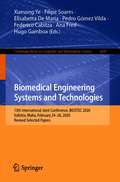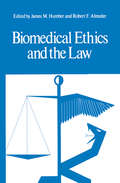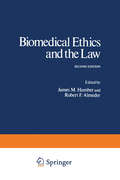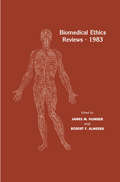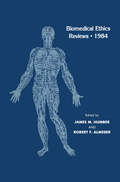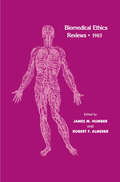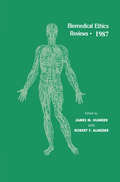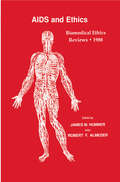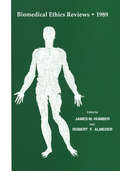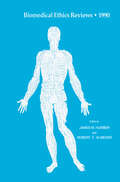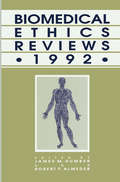- Table View
- List View
Biomedical Engineering Systems and Technologies: 10th International Joint Conference, BIOSTEC 2017, Porto, Portugal, February 21–23, 2017, Revised Selected Papers (Communications in Computer and Information Science #881)
by Nathalia Peixoto Margarida Silveira Hesham H. Ali Carlos Maciel Egon L. van den BroekThis book constitutes the thoroughly refereed post-conference proceedings of the 10th International Joint Conference on Biomedical Engineering Systems and Technologies, BIOSTEC 2017, held in Porto, Portugal, in February 2017.The 20 revised full papers presented were carefully reviewed and selected from a total of 297 submissions. The papers are organized in topical sections on biomedical electronics and devices; bioimaging; bioinformatics models, methods and algorithms; bio-inspired systems and signal processing; and health informatics.
Biomedical Engineering Systems and Technologies: 7th International Joint Conference, BIOSTEC 2014, Angers, France, March 3-6, 2014, Revised Selected Papers (Communications in Computer and Information Science #511)
by Guy Plantier Tanja Schultz Ana Fred Hugo GamboaThis book constitutes the thoroughly refereed post-conference proceedings of the 7th International Joint Conference on Biomedical Engineering Systems and Technologies, BIOSTEC 2014, held in Angers, France, in March 2014. The 25 revised full papers presented were carefully reviewed and selected from a total of 362 submissions. The papers cover a wide range of topics and are organized in topical sections on biomedical electronics and devices; bioimaging; bioinformatics models, methods and algorithms; bio-inspired systems and signal processing; health informatics.
Biomedical Engineering Systems and Technologies: 12th International Joint Conference, BIOSTEC 2019, Prague, Czech Republic, February 22–24, 2019, Revised Selected Papers (Communications in Computer and Information Science #1211)
by Ana Roque Arkadiusz Tomczyk Elisabetta De Maria Felix Putze Roman Moucek Ana Fred Hugo GamboaThis book constitutes the thoroughly refereed post-conference proceedings of the 12th International Joint Conference on Biomedical Engineering Systems and Technologies, BIOSTEC 2019, held in Prague, Czech Republic, in February 2019.The 22 revised and extended full papers presented were carefully reviewed and selected from a total of 271 submissions. The papers are organized in topical sections on biomedical electronics and devices; bioimaging; bioinformatics models, methods and algorithms; bio-inspired systems and signal processing health informatics.
Biomedical Engineering Systems and Technologies: 13th International Joint Conference, BIOSTEC 2020, Valletta, Malta, February 24–26, 2020, Revised Selected Papers (Communications in Computer and Information Science #1400)
by Xuesong Ye Filipe Soares Elisabetta De Maria Pedro Gómez Vilda Federico Cabitza Ana Fred Hugo GamboaThis book constitutes extended and revised versions of the selected papers from the 13th International Joint Conference on Biomedical Engineering Systems and Technologies, BIOSTEC 2020, held in Valletta, Malta, in February 2020.The 29 revised and extended full papers presented were carefully reviewed and selected from a total of 363 submissions. The papers are organized in topical sections on biomedical electronics and devices; bioimaging; bioinformatics models, methods and algorithms; bio-inspired systems and signal processing; health informatic
Biomedical Engineering Technologies: Volume 1 (Methods in Molecular Biology #2393)
by Miguel R. Ossandon Houston Baker Avraham RasoolyThis volume provides detailed technical protocols on current biosensors and imaging technologies and Chapters focus on optical, electrochemical, Quartz crystal microbalance (QCM) biosensors and on medical imaging technologies such as tomography, MRI, and NMR. Written in the format of the highly successful Methods in Molecular Biology series, each chapter includes an introduction to the topic, lists necessary materials and reagents, includes tips on troubleshooting and known pitfalls, and step-by-step, readily reproducible protocols. Authoritative and practical, Biomedical Engineering Technologies, Volume 1 provides technical details in descriptions of major technologies by experts in the field.
Biomedical Engineering Technologies: Volume 2 (Methods in Molecular Biology #2394)
by Avraham Rasooly Houston Baker Miguel R. OssandonThis volume provides detailed technical protocols on current biomedical technologies and examples of their applications and capabilities. Chapters focus on molecular and cellular analytical methods, experimental new drug delivery approaches, guided surgery, implants and tissue engineering. Written in the format of the highly successful Methods in Molecular Biology series, each chapter includes an introduction to the topic, lists necessary materials and reagents, tips on troubleshooting and known pitfalls, and step-by-step, readily reproducible protocols. Authoritative and practical, Biomedical Engineering Technologies, Volume 2 provides technical details in descriptions of major technologies by experts in the field.
Biomedical Entanglements: Conceptions of Personhood in a Papua New Guinea Society (Person, Space and Memory in the Contemporary Pacific #5)
by Franziska A. HerbstBiomedical Entanglements is an ethnographic study of the Giri people of Papua New Guinea, focusing on the indigenous population’s interaction with modern medicine. In her fieldwork, Franziska A. Herbst follows the Giri people as they circulate within and around ethnographic sites that include a rural health center and an urban hospital. The study bridges medical anthropology and global health, exploring how the ‘biomedical’ is imbued with social meaning and how biomedicine affects Giri ways of life.
Biomedical EPR - Part A: Free Radicals, Metals, Medicine and Physiology (Biological Magnetic Resonance #23)
by Sandra S. Eaton Gareth R. Eaton Lawrence J. BerlinerBiomedical EPR – Part A focuses on applications of EPR spectroscopy in the areas of free radicals, metals, medicine, and physiology. The book celebrates the 70th birthday of Prof. James S. Hyde, Medical College of Wisconsin, and his contributions to this field. Chapters are written to provide introductory material for new-comers to the field which lead into up-to-date reviews that provide perspective on the wide range of questions that can be addressed by EPR. Key Features:Free Radicals in Medicine Radicals in vivo and in Model Systems, and their Study by Spin Trapping In vivo EPR, including Oximetry and Imaging Time Domain EPR at Radio Frequencies EPR of Copper Complexes: Motion and Frequency Dependence Time Domain EPR and Electron Spin Echo Envelope Modulation
Biomedical EPR - Part B: Methodology, Instrumentation, and Dynamics (Biological Magnetic Resonance #24)
by Sandra S. Eaton Gareth R. Eaton Lawrence BerlinerBiomedical EPR – Part B focuses on applications of EPR techniques and instrumentation, with applications to dynamics. The book celebrates the 70th birthday of Prof. James S. Hyde, Medical College of Wisconsin, and his contributions to this field. Chapters are written to provide introductory material for new-comers to the field that lead into up-to-date reviews that provide perspective on the wide range of questions that can be addressed by EPR. Key Features:EPR Techniques including Saturation Recovery, ENDOR, ELDOR, and Saturation Transfer Instrumentation Innovations including Loop Gap Resonators, Rapid Mixing, and Time Locked Sub-Sampling Motion in Biological Membranes Applications to Structure Determination in Proteins Discussion of Trends in EPR Technology and Prognosis for the Future
Biomedical Ethics and the Law
by James M. Humber Robert F. AlmederIn the past few years an increasing number of colleges and universities have added courses in biomedical ethics to their curricula. To some extent, these additions serve to satisfy student demands for "relevance. " But it is also true that such changes reflect a deepening desire on the part of the academic community to deal effectively with a host of problems which must be solved if we are to have a health-care delivery system which is efficient, humane, and just. To a large degree, these problems are the unique result of both rapidly changing moral values and dramatic advances in biomedical technology. The past decade has witnessed sudden and conspicuous controversy over the morality and legality of new practices relating to abortion, therapy for the mentally ill, experimentation using human subjects, forms of genetic interven tion, suicide, and euthanasia. Malpractice suits abound and astronomical fees for malpractice insurance threaten the very possibility of medical and health-care practice. Without the backing of a clear moral consensus, the law is frequently forced into resolving these conflicts only to see the moral issues involved still hotly debated and the validity of existing law further questioned. In the case of abortion, for example, the laws have changed radically, and the widely pub licized recent conviction of Dr. Edelin in Boston has done little to foster a moral consensus or even render the exact status of the law beyond reasonable question.
Biomedical Ethics and the Law
by James M. Humber Robert F. AlmederIn the past few years, an increasing number of colleges and universities have added courses in biomedical ethics to their curricula. To some extent, these additions serve to satisfy student demands for "relevance. " But it is also true that such changes reflect a deepening desire on the part of the academic community to deal effectively with a host of problems which must be solved if we are to have a health-care delivery system which is efficient, humane, and just. To a large degree, these problems are the unique result of both rapidly changing moral values and dramatic advances in biomedical technology. The past decade has witnessed sudden and conspicuous controversy over the morality and legality of new practices relating to abortion, therapy for the mentally ill, experimentation using human subjects, forms of genetic interven tion, and euthanasia. Malpractice suits abound, and astronomical fees for malpractice insurance threaten the very possibility of medical and health-care practice. Without the backing of a clear moral consensus, the law is frequently forced into resolving these conflicts only to see the moral issues involved still hotly debated and the validity of the existing law further questioned. Take abortion, for example. Rather than settling the legal issue, the Supreme Court's original abortion decision in Roe v. Wade (1973), seems only to have spurred further legal debate. And of course, whether or not abortion is a mo rally ac ceptable procedure is still the subject of heated dispute.
Biomedical Ethics Reviews · 1983 (Biomedical Ethics Reviews)
by James M. Humber Robert F. AlmederIn the past decade the body of literature in the area of biomedical ethics has expanded at an astounding rate. Indeed, on every major topic, the literature in this area has mUltiplied, and continues to do so, so rapidly that one can easily fall behind important advances in our thinking about and understanding of the problems of contemporary bioethics. Awareness of this need to keep apace of developments in the area prompted a recent reviewer of our earlier collection Biomedical Ethics and the Law (Plenum, 2nd edition, 1979) to suggest that somebody ought to offer the service of providing a biennial review or update of the literature on the various central topics in bioethics. Thomas Lanigan, of The Humana Press, agreed with this last sug gestion and so asked us to edit a series of texts consisting of previously unpublished essays on selected topics, a series that would seek to re view and update recent literature on the central topics, while also striv ing to advance distinctive solutions to the problems on the topics under discussion. Accordingly, this first collection of previously unpublished essays focuses on the selected topics, and the authors commissioned were charged with addressing the basic problems assigned while also bringing the reader either directly or indirectly up to date on the rele vant literature.
Biomedical Ethics Reviews · 1984 (Biomedical Ethics Reviews)
by James M. Humber Robert F. AlmederThis is the second volume of Biomedical Ethics Reviews, a series of texts designed to review and update the literature on issues of central importance in bioethics today. Five topics are dis cussed in the present volume. Section I, Public Policy andRe search with Human Subjects, reviews the history of the moral issues involved in the history of research with human subjects, and confronts most of the major legal and moral problems involving research on human subjects. Questions addressed in this section range from those concerning informed and proxy consent to those dealing with the adequacy of monitoring hu man research via institutional review boards (IRBs). Section II deals with a second broad topic in bioethics, The Right to Health Care in a Democratic Society. Here the concern not merely that of determining whether there is a right to is health care, but also, if there is such a right, how it ought best be understood and implemented. To answer questions such as these, we learn that one must distinguish legal from moral rights, assess the merits of various theories of rights, clarify the relationship between rights and duties, and attempt to deter mine a just method for the distribution of health care. Advances in medical technology often pose new legal and moral problems for legislators and health care practitioners.
Biomedical Ethics Reviews · 1985 (Biomedical Ethics Reviews)
by James M. Humber Robert F. AlmederBiomedical Ethics Reviews: 1985 is the third volume in a series of texts designed to review and update the literature on issues of central impor tance in bioethics today. Four topics are discussed in the present volume: ( 1) Should citizens of the United States be permitted to buy, sell, and broker human organs? (2) Should sex preselection be legally proscribed? (3) What decision-making procedure should medical per sonnel employ in those cases where there is a high degree of uncer tainty? (4) What do we mean when we use the terms "health" and "disease"? Each topic constitutes a separate section in our text; intro ductory essays briefly summarize the contents of each section. Bioethics is, by its nature, interdisciplinary in character. Recognizing this fact, the authors represented in the present volume have made every effort to minimize the use of technical jargon. At the same time, we believe the purpose of providing a review of the recent literature, as well as of advancing bioethical discussion, is admirably served by the pieces collected herein. We look forward to the next volume in our series, and very much hope the reader will also.
Biomedical Ethics Reviews · 1987 (Biomedical Ethics Reviews)
by James M. Humber Robert F. AlmederBiomedical Ethics Reviews • 1987 is the fifth volume in a series of texts designed to review and update the literature on issues of central importance in bioethics today. Three topics are discussed in the present volume: (1) Prescribing Drugs for the Aged and Dying; (2) Animals as a Source of Human Transplant Organs, and (3) The Nurse's Role: Rights and Responsibilities. Each topic constitutes a separate sec tion in our text; introductory essays briefly summarize the contents of each section. Bioethics is, by its nature, interdisciplinary in character. Recognizing this fact, the authors represented in the present volume have made every effort to minimize the use of techni cal jargon. At the same time, we believe the purpose of pro viding a review of the recent literature, as well as of advancing bioethical discussion, is admirably served by the pieces col lected herein. We look forward to the next volume in our series, and very much hope the reader will also.
Biomedical Ethics Reviews · 1988 (Biomedical Ethics Reviews)
by James M. Humber Robert F. AlmederBiomedical Ethics Reviews is an annual publication designed to review and update the literature on issues of central importance in bioethics today. Ordinarily, more than one topic is discussed in each volume of Biomedical Ethics Reviews. This year, however, we have decided to devote the entire volume of Biomedical Ethics Reviews: 1988 to disussion of one topic, namely, AIDS. The ra tionale for this decision should be clear: AIDS is arguably the most serious public health threat facing our nation today, and the char acter of the disease is such that it creates special problems for ethicists, philosophers, theologians, educators, jurists, health care professionals, and politicians. Indeed, the questions that AIDS gives rise to are so numerous and complex that no one text could hope to treat them exhaustively. Still, if it is impossible, in anyone text, to deal with all of the perplexing difficulties that AIDS generates, it nevertheless remains true that each addition to the AIDS literature contributes to our collective knowledge, and in so doing, brings us one step closer to resolving at least some of the problems associated with the disease. We believe that the articles included in the present volume of Biomedical Ethics Reviews serve this purpose admirably, and we hope the reader will agree. James M. Humber Robert F. Almeder vii Contributors Ronald Carson • Medical Humanities Institute, University of Texas Medical Branch, Galveston, Texas David J.
Biomedical Ethics Reviews · 1989 (Biomedical Ethics Reviews)
by James M. Humber Robert F. AlmederBiomedical Ethics Reviews • 1989 is the seventh volume in a series of texts designed to review and update the literature on issues of central importance in bioethics today. Three topics are discussed in the present volume: (1) Should Abnormal Fetuses Be Brought to Term for the Sole Purpose of Providing Infant Transplant Organs? (2) Should Physicians Dispense Drugs for Profit? and (3) Should Human Death Be Taken to Occur When Persons Perma nently Lose Consciousness? Each topic constitutes a separate section in our text; introductory essays briefly summarize the contents of each section. Bioethics is, by its nature, interdisciplinary in character. Recog nizing this fact, the authors represented in the present volume have made every effort to minimize the use of technical jargon. At the same time, we believe the purpose of providing a review of the recent literature, as well as of advancing bioethical discussion, is admirably served by the pieces collected herein. We look forward to the next volume in our series, and very much hope the reader will also.
Biomedical Ethics Reviews · 1990 (Biomedical Ethics Reviews)
by James M. Humber Robert F. AlmederBiomedical Ethics Reviews • 1990 is the eighth volume in a series of texts designed to review and update the literature on issues of central importance in bioethics today. Two topics are discussed in the present volume: (1) Should the United States Adopt a National Health Insurance Plan? and (2) Are the NIH Guidelines Adequate for the Care and Protection of Laboratory Animals? Each topic constitutes a separate section in our text; introductory essays briefly summarize the contents of each section. Bioethics is, by its nature, interdisciplinary in character. Recog nizing this fact, the authors represented in the present volume have made every effort to minimize the use of technical jargon. At the same time, we believe the purpose of providing a review of the recent literature, as well as of advancing bioethical discussion, is admirably served by the pieces collected herein. We look forward to the next volume in our series, and very much hope the reader will also.
Biomedical Ethics Reviews · 1992 (Biomedical Ethics Reviews)
by James M. Humber Robert F. AlmederBiomedical Ethics Reviews: 1992 is the tenth volume in a series of texts designed to review and update the literature on issues of central importance in bioethics today. Two topics are discussed in the present volume: (1) Bioethics and the Military, and (2) Compulsory Birth Control. Each topic constitutes a separate section in our text; introductory essays briefly summarize the contents of each section. Bioethics is, by its nature, interdisciplinary in character. Recog nizing this fact, the authors represented in the present volume have made every effort to minimize the use of technical jargon. At the same time, we believe the purpose of providing a review of the recent literature, as well as of advancing bioethical discussion, is well served by the pieces collected herein. We look forward to the next volume in our series, and very much hope the reader will also. James M. Humber Robert F. Almeder vii Contributors Paul Christopher • Department of English and Philosophy Division, US Military Academy, West Point, New York Gerard Elfstrom • Department of Philosophy, Auburn University, Auburn, Alabama Nicholas Fotion • Department of Philosophy, Emory University, Atlanta, Georgia Martin Gunderson • Department of Philosophy, Macalester College, St.
Biomedical Fluid Dynamics: Flow and Form
by Troy ShinbrotThis is a readable and attractively presented textbook on fluid flow in biological systems that includes flow through blood vessels, pulsatile flow, and pattern formation. It bridges the divide among biomedical engineering students between those with an engineering and those with a bio-scientific background, by offering guidance in both physiological and mathematical aspects of the subject. Every chapter includes surprising, amusing, and stimulating effects that the reader may want to experiment on their own. Brief historical vignettes are also included throughout this book. We in the 21st century can so easily turn to the computer to provide a solution, that we forget the extraordinary sparks of insight that scientists in centuries past had to rely on to provide us with the foundational understanding and analytical tools that we now depend on. This book is an attempt to maintain our roots in past investigations, while giving us wings to explore future ones.
Biomedical Image Analysis: Segmentation (Synthesis Lectures on Image, Video, and Multimedia Processing)
by Scott Acton Nilanjan RayThe sequel to the popular lecture book entitled Biomedical Image Analysis: Tracking, this book on Biomedical Image Analysis: Segmentation tackles the challenging task of segmenting biological and medical images. The problem of partitioning multidimensional biomedical data into meaningful regions is perhaps the main roadblock in the automation of biomedical image analysis. Whether the modality of choice is MRI, PET, ultrasound, SPECT, CT, or one of a myriad of microscopy platforms, image segmentation is a vital step in analyzing the constituent biological or medical targets. This book provides a state-of-the-art, comprehensive look at biomedical image segmentation that is accessible to well-equipped undergraduates, graduate students, and research professionals in the biology, biomedical, medical, and engineering fields. Active model methods that have emerged in the last few years are a focus of the book, including parametric active contour and active surface models, active shape models, and geometric active contours that adapt to the image topology. Additionally, Biomedical Image Analysis: Segmentation details attractive new methods that use graph theory in segmentation of biomedical imagery. Finally, the use of exciting new scale space tools in biomedical image analysis is reported. Table of Contents: Introduction / Parametric Active Contours / Active Contours in a Bayesian Framework / Geometric Active Contours / Segmentation with Graph Algorithms / Scale-Space Image Filtering for Segmentation
Biomedical Image Analysis: Tracking (Synthesis Lectures on Image, Video, and Multimedia Processing)
by Scott T. Acton Nilanjan RayIn biological and medical imaging applications, tracking objects in motion is a critical task. This book describes the state-of-the-art in biomedical tracking techniques. We begin by detailing methods for tracking using active contours, which have been highly successful in biomedical applications. The book next covers the major probabilistic methods for tracking. Starting with the basic Bayesian model, we describe the Kalman filter and conventional tracking methods that use centroid and correlation measurements for target detection. Innovations such as the extended Kalman filter and the interacting multiple model open the door to capturing complex biological objects in motion. A salient highlight of the book is the introduction of the recently emerged particle filter, which promises to solve tracking problems that were previously intractable by conventional means. Another unique feature of Biomedical Image Analysis: Tracking is the explanation of shape-based methods for biomedical image analysis. Methods for both rigid and nonrigid objects are depicted. Each chapter in the book puts forth biomedical case studies that illustrate the methods in action.
Biomedical Image Analysis
by Rangaraj M. RangayyanComputers have become an integral part of medical imaging systems and are used for everything from data acquisition and image generation to image display and analysis. As the scope and complexity of imaging technology steadily increase, more advanced techniques are required to solve the emerging challenges.Biomedical Image Analysis demonstr
Biomedical Image Analysis Recipes in MATLAB: For Life Scientists and Engineers
by Constantino Carlos Reyes-AldasoroAs its title suggests, this innovative book has been written for life scientists needing to analyse their data sets, and programmers, wanting a better understanding of the types of experimental images life scientists investigate on a regular basis. Each chapter presents one self-contained biomedical experiment to be analysed. Part I of the book presents its two basic ingredients: essential concepts of image analysis and Matlab. In Part II, algorithms and techniques are shown as series of "recipes" or solved examples that show how specific techniques are applied to a biomedical experiments like Western Blots, Histology, Scratch Wound Assays and Fluoresence. Each recipe begins with simple techniques that gradually advance in complexity. Part III presents some advanced techniques for the generation of publication quality figures. The book does not assume any computational or mathematical expertise. A practical, clearly-written introduction to biomedical image analysis that provides the tools for life scientists and engineers to use when solving problems in their own laboratories. Presents the basic concepts of MATLAB software and uses it throughout to show how it can execute flexible and powerful image analysis programs tailored to the specific needs of the problem. Within the context of four biomedical cases, it shows algorithms and techniques as series of "recipes", or solved examples that show how a particular technique is applied in a specific experiment. Companion website containing example datasets, MATLAB files and figures from the book.



